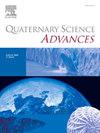Microfacies analysis and varve-based chronology reveal a variable 14C reservoir effect in Lake Shira, northern Inner Asia, over the past 2500 years
IF 2.2
Q2 GEOGRAPHY, PHYSICAL
引用次数: 0
Abstract
Here, we present the first fully varve-based chronology for the deposits of the deep-water Lake Shira (Chulym-Yenisei Basin, South Siberia), derived from a new sediment core. The very well-preserved varves show typical properties of the clastic-biogenic and endogenic types that can be subdivided into four sublayers representing winter–early spring, late spring, early summer and late summer–autumn. The analysed sediment section of 147 cm length comprises 2491 varve years with a total counting error of 1.6 % (i.e. ±40 years), making the new sediment core from Lake Shira a unique high-resolution archive for multi-proxy studies of past climate/environmental change and human-environment interactions. Direct comparison of nine AMS radiocarbon (14C) dates based on sediment bulk organic fractions with an age-depth model based on varve counting made it possible to examine the 14C reservoir effect in the lake. The reservoir effect is a common issue when estimating the age of environmental proxies from lacustrine sedimentary archives in Inner Asia. Although a constant reservoir effect is commonly used to correct the 14C dates from a single core or lake basin, our results from Lake Shira demonstrate that it varies significantly over the last 2500 years, ranging from 240 ± 30 to 1045 ± 30 years. The spatiotemporal variability of the reservoir effect can considerably reduce the accuracy of age-depth models based solely on the bulk organic sediment fraction. Where varved sediment is unavailable, as is usually the case, lignin phenols, terrestrial plant remains and purified pollen concentrates should be considered as alternative dating materials.
微相分析和基于变量的年代学揭示了内亚北部示拉湖2500年来变化的14C储层效应
在这里,我们提出了第一个完全基于阀门的沉积物年代学(chulim - yenisei盆地,南西伯利亚),来自一个新的沉积物岩心。保存完好的碎屑岩具有典型的经典生物源型和内源型特征,可分为冬—早春、晚春、初夏和夏末—秋4个亚层。分析的147cm沉积物剖面包含2491年,总计数误差为1.6%(±40年),为研究过去气候/环境变化和人类与环境相互作用的多代理研究提供了独特的高分辨率档案。将基于沉积物体积有机组分的9个AMS放射性碳(14C)测年与基于阀计数的年龄深度模型进行直接比较,可以检验湖泊中的14C储层效应。从内亚湖相沉积档案中估计环境代用品的年龄时,储层效应是一个常见的问题。虽然恒定的储层效应通常用于校正单个岩心或湖盆的14C测年,但我们对设拉湖的研究结果表明,在过去的2500年里,它在240±30到1045±30年之间发生了显著变化。储层效应的时空变异性会大大降低单纯基于有机沉积物体积分数的年龄-深度模型的准确性。通常情况下,在无法获得分离沉积物的情况下,应考虑将木质素酚、陆生植物遗骸和纯化的花粉浓缩物作为替代测年材料。
本文章由计算机程序翻译,如有差异,请以英文原文为准。
求助全文
约1分钟内获得全文
求助全文
来源期刊

Quaternary Science Advances
Earth and Planetary Sciences-Earth-Surface Processes
CiteScore
4.00
自引率
13.30%
发文量
16
审稿时长
61 days
 求助内容:
求助内容: 应助结果提醒方式:
应助结果提醒方式:


